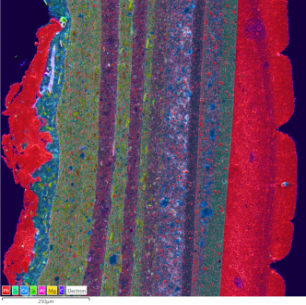関連: ケミカル・触媒
化学と構造によるスタンダードの真正性判断

Ensuring standards in a finished product is of importance in any industry but potentially even more so in chemicals manufacturing. Where process variation can lead to products with significant health or environmental impact. These process variations can be identified through variation away from a typical elemental fingerprint. It may not even be a process variation, identifying older chemicals that no longer adhere to current safety standards is also extremely important. One such example would be identifying lead-containing paint. Using EDS in the SEM allows micron scale elemental analysis of paints even allowing painted layers to be analysed in cross sections to identify buried layers of these potentially harmful materials.
EDS in the SEM can also be used to characterise the chemical fingerprint of paint. These fingerprints can then be used to identify the pigments used in historical artwork. This critical work allows the confirmation of the authenticity and provenance of historic pieces. For certain material, a chemical fingerprint is not enough, in these cases using electron backscatter diffraction (EBSD) can confirm the specific phase of a material. Symmetry EBSD’s CMOS sensitivity allow quick and accurate analysis of these materials to confirm the exact pigment and verify a historic piece of art.